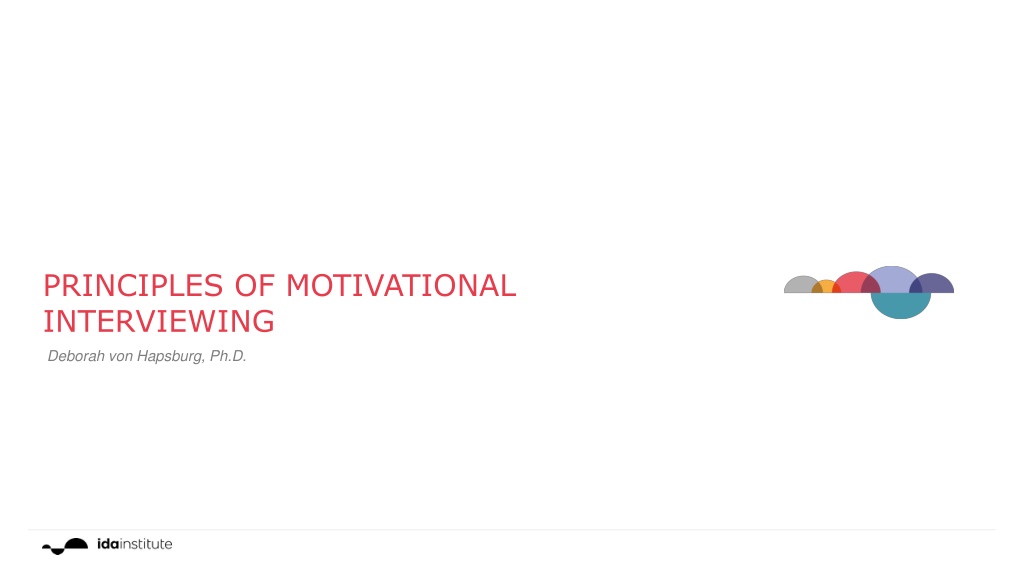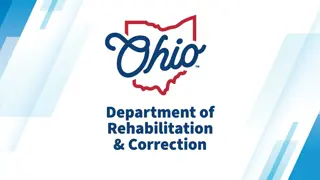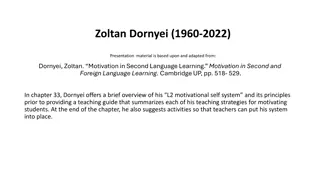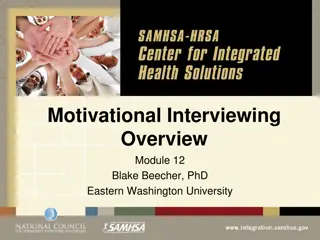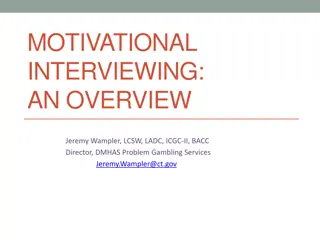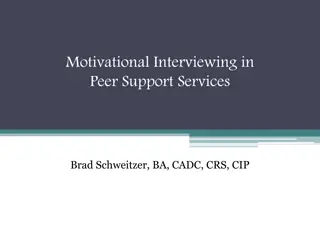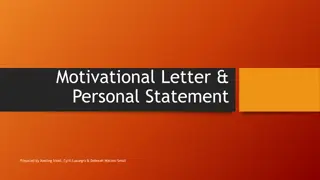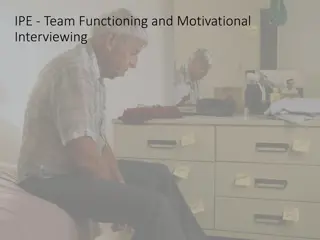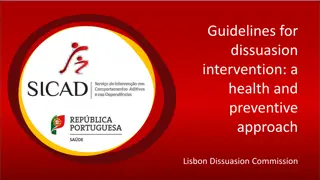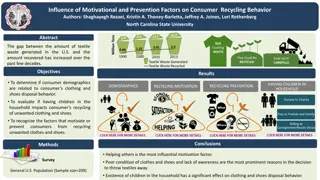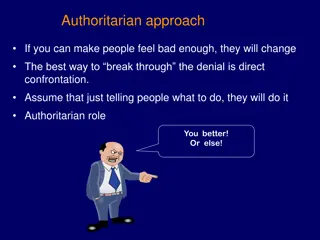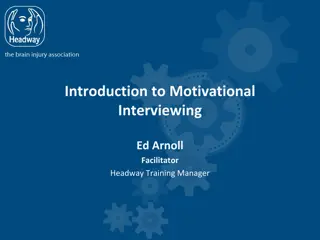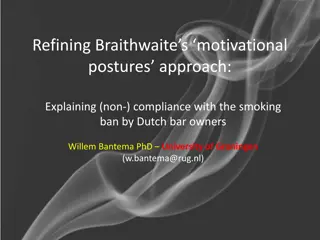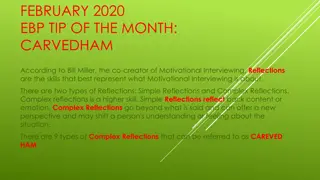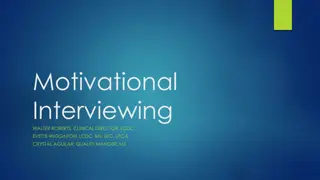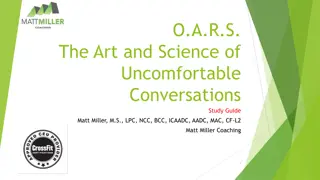PRINCIPLES OF MOTIVATIONAL INTERVIEWING
Introduce methods to engage patients in change, understand decision-making processes, and utilize Motivational Interviewing techniques synergistically to improve patient outcomes in Audiology. Explore the collaborative, goal-oriented style of Motivational Interviewing, focusing on patient-centered counseling, normalizing resistance to change, and fluctuating motivation levels.
Download Presentation

Please find below an Image/Link to download the presentation.
The content on the website is provided AS IS for your information and personal use only. It may not be sold, licensed, or shared on other websites without obtaining consent from the author. Download presentation by click this link. If you encounter any issues during the download, it is possible that the publisher has removed the file from their server.
E N D
Presentation Transcript
PRINCIPLES OF MOTIVATIONAL INTERVIEWING Deborah von Hapsburg, Ph.D.
GOALS Goal 1: To introduce methods and processes to engage patients in the process of change Goal 2: To introduce the concept and principles of motivational interviewing (MI) Goal 3: To understand the decision making process and the Decision Balance method Goal 4: To introduce the Process of Change model Goal 5: To understand how MI techniques in combination with understanding decisional balance and the process of change can be used synergistically to help improve patient outcomes in Audiology Slide 2 27.2.2025
FACTS Fact 1: Fact 2: Patients with chronic illness self- manage their conditions. Patients are in control no matter what we, as health professionals, do or say. Slide 3 27.2.2025
WAYS TO SUPPORT CLIENTS Motivational Interviewing (Miller and Rollnick, 2002, 2012) Decisional Balance (Janis and Mann, 1977) Stages of Change (Prochaska and DiClemente, 1983) Slide 5 27.2.2025
WHAT IS OUR ROLE IN PROMOTING CHANGE? Patient s Role: Clinician s Role: When it comes to changing life-style and behaviors give ownership and control back to the patient. Introduce the language or question of change and keep it on the agenda Open the dialogue Support patients as they do the hard work themselves Slide 6 27.2.2025
WHAT IS MOTIVATIONAL INTERVIEWING? Motivational Interviewing is a collaborative, goal-oriented style of communication with particular attention to the language of change. It is designed to strengthenpersonal motivation for and commitment to a specific goal by eliciting and exploring the person s own reasons for change within an atmosphere of acceptance and compassion. (Miller & Rollnick, 2012) Slide 7 27.2.2025
MOTIVATIONAL INTERVIEWING - FOUNDATIONS 1. Patient-centered counseling approach 2. Resistance to change and ambivalence are normal processes in changing behaviors, and should be recognized and accepted. 3. Motivation to change is situational and can fluctuate depending on personal experiences. 4. The main focus of MI is to facilitate behavior change by helping patients to explore and resolve their ambivalence about behavior change. 5. MI is a protocol that can be used to increase patient adherence to audiologic recommendations. (Miller & Rollnick, 2002) Slide 8 27.2.2025
PRINCIPLES OF MOTIVATIONAL INTERVIEWING - RULE R - Resist the righting reflex: Roll with Resistance U - Understand your client s motivation: Develop Discrepancy L - Listen to your client: Express Empathy and Avoid Argumentation E - Empower your client: Self-Efficacy Slide 9 27.2.2025
ROLES IN MOTIVATIONAL INTERVIEWING Patient s task: To articulate and resolve his/her own ambivalence Practitioner s tasks: To expect and recognize ambivalence and to be directive in helping the patient examine and resolve the ambivalence Slide 10 27.2.2025
OVERVIEW OF STEPS IN THE MOTIVATIONAL INTERVIEW PROCESS 1. Understand the Patient Perspective 2. Identify Change Talk 3. Use a guiding style 4. Help develop discrepancy with Tools (pros and cons) 5. Understand how important it is to change 6. Understand how confident they feel about changing Slide 11 27.2.2025
SUMMARY OF MOTIVATIONAL INTERVIEWING 3 Core Concepts 4 Core Principles 3 Core Skills Readiness Ambivalence Resistance Express Empathy Develop Discrepancy Roll with Resistance Support Self Efficacy Empathic listening Eliciting self-motivation statements Responding to resistance Slide 12 27.2.2025
CLASS ACTIVITY 2 VIDEO - ITS A PERSONAL THING Are the principles of Motivational Interviewing evident in this encounter?
CLASS DISCUSSION - RULE R - Resist the righting reflex: Roll with Resistance U - Understand your client s motivation: Develop Discrepancy L - Listen to your client: Express Empathy and Avoid Argumentation E - Empower your client: Self-Efficacy Slide 14 27.2.2025
ROLES IN MOTIVATIONAL INTERVIEWING Did Jim explore discrepancy? Did he know how? Decisional Balance Tool (The Box) Helps Clarify decision making Helps patients evaluate alternatives and consequences Helps patients fully consider implementation of decision Slide 15 27.2.2025
THE BOX: DECISIONAL BALANCE 1. What are the benefits of no action? 2. What is the cost of no action? 3. What are the potential costs of taking action? 4. What are the potential benefits of taking action? Adapted from Janis and Mann 1977 Status quo : making no change in respect of hearing situation Change : adopting instruments/strategies to hear better Slide 16 27.2.2025
TRANSTHEORETICAL MODEL AND THE STAGES OF CHANGE 1. Theory of Intentional Behavior Change 2. Successful change only happens when a person is ready to change 3. Change occurs over time, in a cyclical process 4. Attitude change precedes behavior change 5. Distinct stages mark the change process Pre-contemplation Contemplation Preparation Action Maintenance Relapse Permanent Exit ( Prochaska, DiClemente, Norcross, 1993) Slide 17 27.2.2025
THE CIRCLE Outer Circle Inner Circle Middle Circle Support Needed Change Process Stages of Change Jorgensen, S.V., Hansen, H.V., Hessov, I.B., Lauritsen, J.B., Madelung, S. & Tonnesen, H. (2003). Operation Complications are preventable; Copenhagen, International Health Promoting Hospitals & Health Services, Bispebjerg Hospital. Slide 18 27.2.2025
PRE-CONTEMPLATION Patient: Considers comments and information as irrelevant, misplaced or interfering Makes excuses for own behaviour Is surprised when presented with others perception of problems Avoid talking, thinking or reading about change Slide 19 27.2.2025
CONTEMPLATION Patient: More aware of the pros of changing, BUT ALSO acutely aware of the cons Feels comfortable with present habits BUT ALSO is afraid of the consequences of continuing with present habits Resists the idea of changing habits BUT ALSO wants to change Slide 20 27.2.2025
PREPARATION Patient: Is looking for information on consequences Would like to talk about changing habits Looks for support Would like to do it him/herself Slide 21 27.2.2025
ACTION Patient: Is happy and proud of moving forward Talks about the change, looks for acknowledgement & appreciation Feels that it is not as difficult as expected Is worried about giving up the change and relapsing Slide 22 27.2.2025
MAINTENANCE Patient: Feels successful Is sad and seeks the conflicts sometimes Wants to take up the old habits sometimes Forgets why he or she wanted to change habits Slide 23 27.2.2025
RELAPSE Patient: Feels like a failure Relaxes and enjoys the freedom of old, familiar habits Is angry and annoyed with self Feels as if he/she is being a weak character Is motivated for new attempts regarding changing habits again Slide 24 27.2.2025
THE WHOLE PICTURE: CLINICIAN INTERVENTION GUIDE Slide 25 27.2.2025
SUMMARY: ENGAGING PATIENTS IN THE PROCESS OF CHANGE: Requires use of Motivational Interviewing techniques To engage people in structured and empathic conversations about the process of change. It requires knowledge of the decision making process people go through, and uses tools like the decision balance sheet and the line to develop and understand discrepancy. It requires understanding of the process and the cycle of change in order to tailor the type of counseling and support we provide. These are used together to effectively and compassionately engage patients facing difficult decisions. Slide 26 27.2.2025
REFLECTION MOMENT Think about the principles of Motivational Interviewing RULE. Which one of these principles or set of principles poses the biggest challenge for your clinical practice? Slide 27 27.2.2025
REFERENCES DiClemente, C.C. (2003). Addiction and Change : How addictions develop and addicted people recover. New York: Guilford Press. Greer Clark, J. (2010). The Geometry of Motivation: Circles, Lines, & Boxes, Audiology Today, 32-40. Miller W., & Rollnick S. (2002). Motivational Interviewing: Preparing people for change. (2.ed.). New York: Guilford Press. Miller, WR and Rollnick, S (2012). Motivational Interviewing: Helping People Change (3rd Ed.). New York: Guilford Press. Prochaska, J.O., Norcross J.C., & DiClemente, C.C. (1994). A revolutionary six-stage program for overcoming bad habits and moving your life positively forward. Avon Books. Rollnick, S., Miller, W. & Butler, C. (2008). Motivational interviewing in health care: Helping patients change behavior. New York: Guilford Press. Rosengren, D.B. (2009). Building Motivational Interviewing Skills: A practitioner workbook. New York: Guilford Press. T nnesen, H. (2012). Engage in the Process of Change: Facts and Methods. Slide 28 27.2.2025
